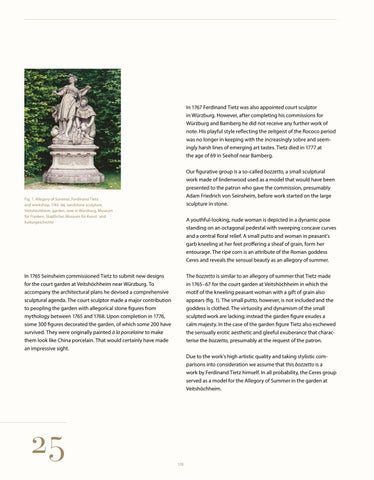In 1767 Ferdinand Tietz was also appointed court sculptor in Würzburg. However, after completing his commissions for Würzburg and Bamberg he did not receive any further work of note. His playful style reflecting the zeitgeist of the Rococo period was no longer in keeping with the increasingly sobre and seemingly harsh lines of emerging art tastes. Tietz died in 1777 at the age of 69 in Seehof near Bamberg. Our figurative group is a so-called bozzetto, a small sculptural work made of lindenwood used as a model that would have been presented to the patron who gave the commission, presumably Adam Friedrich von Seinsheim, before work started on the large sculpture in stone.
Fig. 1. Allegory of Summer, Ferdinand Tietz and workshop, 1765–66, sandstone sculpture, Veitshöchheim, garden, now in Würzburg, Museum für Franken, Staatliches Museum für Kunst- und Kulturgeschichte
A youthful-looking, nude woman is depicted in a dynamic pose standing on an octagonal pedestal with sweeping concave curves and a central floral relief. A small putto and woman in peasant’s garb kneeling at her feet proffering a sheaf of grain, form her entourage. The ripe corn is an attribute of the Roman goddess Ceres and reveals the sensual beauty as an allegory of summer.
In 1765 Seinsheim commissioned Tietz to submit new designs for the court garden at Veitshöchheim near Würzburg. To accompany the architectural plans he devised a comprehensive sculptural agenda. The court sculptor made a major contribution to peopling the garden with allegorical stone figures from mythology between 1765 and 1768. Upon completion in 1776, some 300 figures decorated the garden, of which some 200 have survived. They were originally painted à la porcelaine to make them look like China porcelain. That would certainly have made an impressive sight.
The bozzetto is similar to an allegory of summer that Tietz made in 1765 – 67 for the court garden at Veitshöchheim in which the motif of the kneeling peasant woman with a gift of grain also appears (fig. 1). The small putto, however, is not included and the goddess is clothed. The virtuosity and dynamism of the small sculpted work are lacking; instead the garden figure exudes a calm majesty. In the case of the garden figure Tietz also eschewed the sensually erotic aesthetic and gleeful exuberance that characterise the bozzetto, presumably at the request of the patron. Due to the work’s high artistic quality and taking stylistic comparisons into consideration we assume that this bozzetto is a work by Ferdinand Tietz himself. In all probability, the Ceres group served as a model for the Allegory of Summer in the garden at Veitshöchheim.
25
170

























